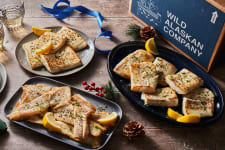
Sockeye vs. King Salmon: Choosing Between Alaska’s Finest
October 30th, 2024Which Is Better, Sockeye or King Salmon?
When it comes to salmon, sockeye and king are two of the most loved species on the market. But which one should you choose for your next meal? Deciding between the two can be tough because each offers something a little different. Both are incredibly delicious with undeniable health benefits. The obvious question is, which one of the two is better? But in Alaska, and to seasoned fishmongers, it’s not, “is sockeye or king salmon better.” It's actually about understanding the distinct qualities and how they can complement your meals and diet.
Difference Between Sockeye and King Salmon
The most obvious difference between sockeye and king salmon is their physical appearance.

Sockeye salmon are revered for their vibrant, deep-red flesh, which is a hallmark of their diet of krill and plankton. This brilliant color makes sockeye stand out in any culinary presentation. As one of the smallest salmon species, sockeye typically weigh between 4 and 15 pounds.

King salmon, also called chinook, live up to their name with impressive size and variability in flesh color. Kings can weigh anywhere from 20 to 50 pounds, with some rarities tipping the scales at over 100 pounds. Their flesh ranges from reddish-orange and pinkish-red to almost white, depending on the fish’s diet. Previously considered inferior, white-fleshed kings are now highly coveted. The different hues of king salmon can add a nice visual variety to your meal, but the taste is similar across the color range.
Taste and Texture
Both sockeye and king salmon have distinct flavor profiles. Sockeye has a bolder, more robust flavor that many seafood enthusiasts love. Its rich, deep flavor pairs beautifully with an herby lemon dill or savory topicals like garlic and smoked paprika. Sockeye’s firm texture makes it ideal for baking, grilling, roasting, or poaching. What’s more, the high oil content in sockeye gives it a satisfying mouthfeel. If you prefer a firm, flavor-forward fish, sockeye salmon is the way to go.
In contrast, king salmon offers a more delicate and buttery flavor with a larger flake. King salmon has a smooth, melt-in-your-mouth texture. It’s a great choice for those who prefer a milder fish taste. The nutritional content of king salmon helps it retain moisture during cooking, preventing overdrying. Baking, pan-searing, and broiling perfectly highlight king salmon's delicate texture. Both king and sockeye are also phenomenal smoking fish.
Nutritional Facts
Sockeye and king salmon are vitamin and omega-3 powerhouses. Sockeye salmon offers a slightly different nutritional profile compared to king salmon. Here’s the nutritional comparison for a 6-ounce serving of sockeye and king salmon:
Sockeye
-
Calories: 220 calories
-
Fat: 10 grams
-
Protein: 34 grams
-
Potassium: 440 milligrams, or 10% RDI
-
Vitamin D: 24 micrograms, or 120% RDI
King
-
Calories: 180 calories
-
Fat: 5 grams
-
Protein: 34 grams
-
Potassium: 700 milligrams, or 15% RDI
-
Vitamin D: 14.9 micrograms, or 70% RDI
Both salmon species provide essential omega-3 fatty acids that are not naturally produced by the body. These good fats help support our body's health and fend off risk factors that cause heart disease.
Availability and Price
Some other considerations that may influence your choice are the availability and price.
Sockeye salmon is generally more abundant and accessible. Wild sockeye salmon is harvested during peak season in Alaska and then flash-frozen to be available year-round. Because of its higher availability, sockeye tends to be more affordable than king salmon. Its consistent flavor and texture, paired with its reasonable price, make it a popular choice for home cooks.
As the most regulated of the Pacific salmon species, king salmon are more limited in supply. For perspective, in 2024, the total allowable catch for commercial and sport fishing was around 211,000 king salmon. The 2024 commercial sockeye fishery alone was forecasted at 39.5 million fish. King salmon's size, rarity, and rich flavor can drive up the price, giving it the perception in the market as a more premium option. King can sometimes cost up to twice as much as sockeye salmon.
When it comes to choosing between sockeye and king salmon, there’s no wrong answer! Both offer incredible flavor and nutrition. Sourced from Alaska’s pristine waters, our salmon is 100% wild-caught by seining, trolling, and gillnetting. These methods, along with Alaska’s strict fishing regulations, ensure that wild salmon stocks remain healthy. Eco-conscious consumers can rest easy knowing they made responsible seafood choices with the Wild Alaskan Company.
Where to Find the Best Wild Salmon
Interested in stocking your kitchen with 100% wild-caught, sustainably harvested seafood? Choose your seafood subscription box today and get it delivered right to your doorstep.





